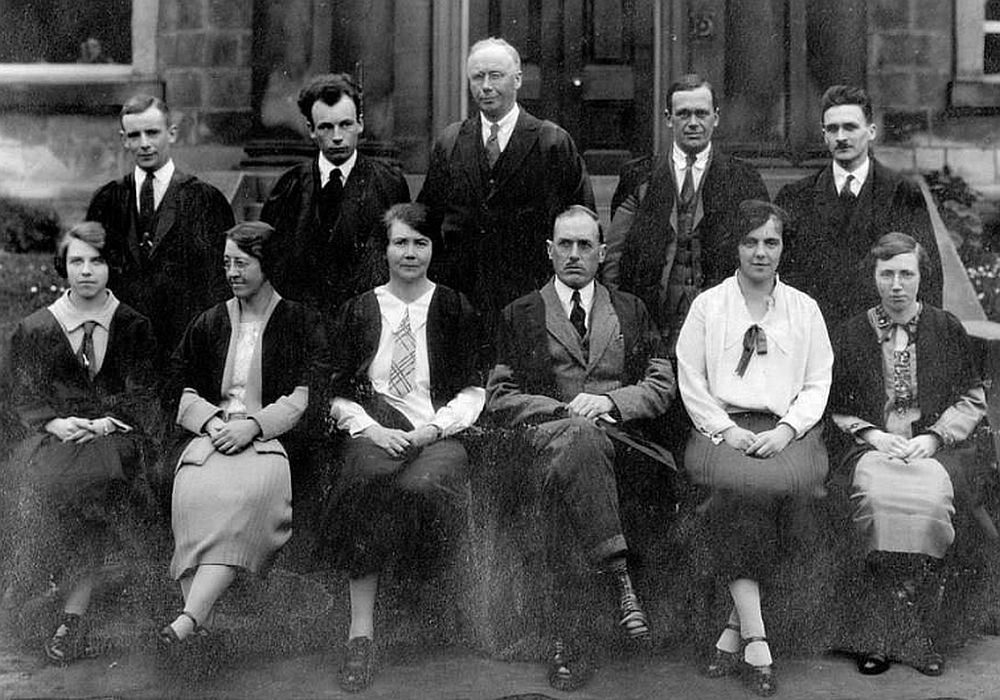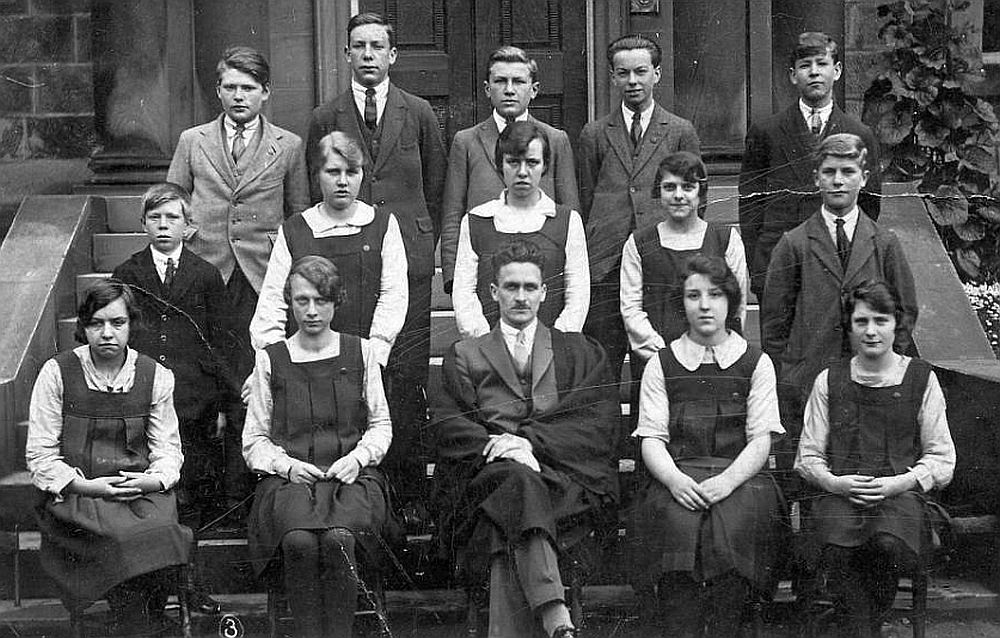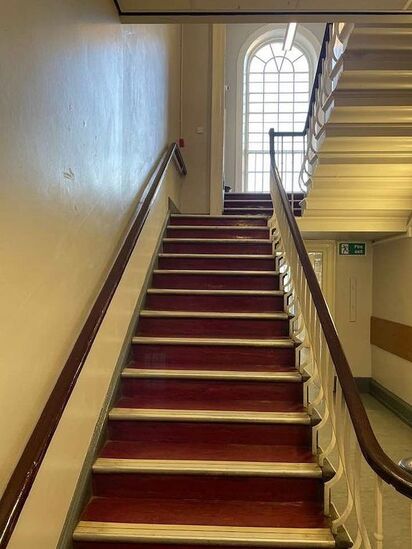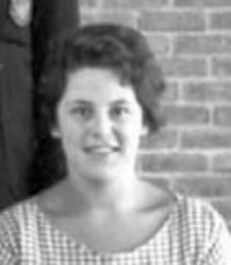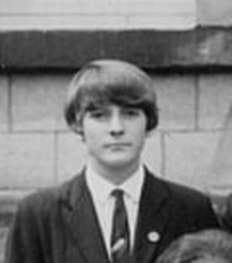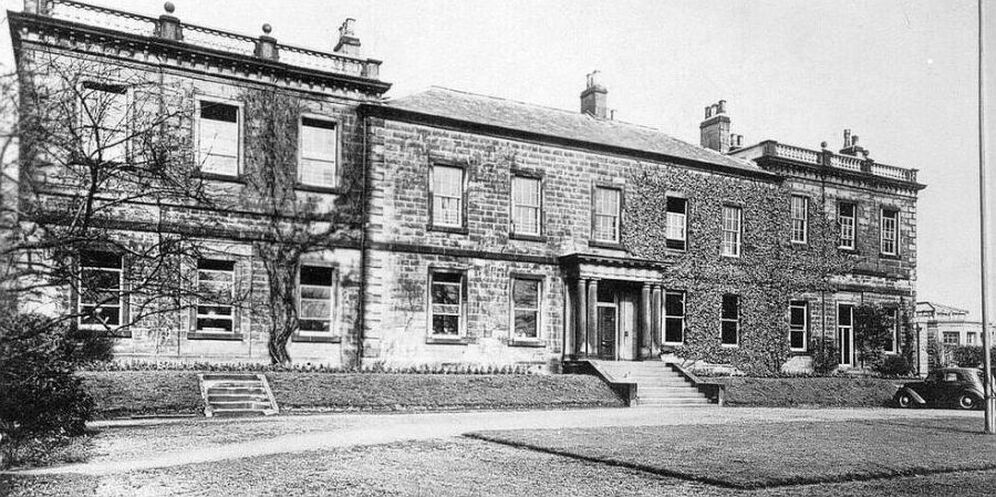Posts about HGS 4
Updated 18.10.2023
Updated 18.10.2023
An example of the Honours Boards in the "Main Hall and Old Gymnasium".
They were removed when the Grammar School closed and the High School was built in the late 1960s.
They were removed when the Grammar School closed and the High School was built in the late 1960s.
Table of Contents
1. Mr Collette
2. The magic Main Staircase, the big window and Room 10
3. Milk Rations in 1935 – A One Act Play
4. Some things are best left alone!
5. Just a photo but it is important to me because.........
1. Mr Collette
2. The magic Main Staircase, the big window and Room 10
3. Milk Rations in 1935 – A One Act Play
4. Some things are best left alone!
5. Just a photo but it is important to me because.........
1. Mr Collette
The Hemsworth Secondary School Teaching Staff of 1925-26
Back Row L-R: Mr. Crossland, Mr. Shiells, Mr. Austin, Mr. Storer, Mr. Collette
Front Row L-R: Miss Shortridge, Miss E.D. Robinson, Miss. Griffiths, Mr. Jenkinson, Miss Morgan-Jones, Miss. Hanson?
Front Row L-R: Miss Shortridge, Miss E.D. Robinson, Miss. Griffiths, Mr. Jenkinson, Miss Morgan-Jones, Miss. Hanson?
Here is one of my favourite HGS teacher, Mr Collette. He had been at the school for nearly 3 years of his 40. Obviously the school was very different then. Even electricity was very new and fires had to be lit and maintained every day in the colder months. I remember the fireplaces in the teaching rooms and Library of the Main Building. The fireplaces were never used as such in my time at HGS, 1955-62.
Dave
Dave
4C 1926-27
Mr Collette would have been about 27 years old when the photograph was taken. He looks very stern but that was not the way he was.
Mr Collette would have been about 27 years old when the photograph was taken. He looks very stern but that was not the way he was.
Photo from Hilary Goulding. Thank you, Hilary.
Back Row L-R: 1, Harold Goulding, 3, 4, 5
Middle Row L-R: 1, 2, 3, Vera Hammill, 5
Front Row L-R: 1, 2, Mr. Collette, 4, 5
Back Row L-R: 1, Harold Goulding, 3, 4, 5
Middle Row L-R: 1, 2, 3, Vera Hammill, 5
Front Row L-R: 1, 2, Mr. Collette, 4, 5
In 1927 there was one First Year Form, three Second Year Forms; two Third Years; three Fourth Years and one Fifth Year Form. Probably 4C was so named because the pupils studied Commercial subjects such as Book-Keeping, Typing and Shorthand, and Commercial Arithmetic. In the summer term of 1928 they took the Elementary Stage Examinations of the Royal Society For the Encouragement of Arts, Manufactures and Commerce, London. (Founded 1754, Incorporated 1847). Mr. Collette had joined the Staff in 1925, and was in charge of the organisation and supervision of this Commercial Curriculum from 1926 onwards.
The HGS Teaching Staff 1939-40
Back Row L-R: Miss Walker, Miss Garman, Mr. Waters, Mr. Scourfield, Mr. Austin, Mr. Storer, Mr. Hyde, Mr. Nelson
Middle Row L-R: Miss Harrison, Miss Bromley, Miss Prince, Miss Shortridge, Mr. Hamilton, Mr. Crossland, Mr. Manning, Mr. Collette, Mr. Hamilton (Art)
Front Row L-R: 1, Miss Kenward, Miss. Euler, 4, 5, Miss Townsend
Middle Row L-R: Miss Harrison, Miss Bromley, Miss Prince, Miss Shortridge, Mr. Hamilton, Mr. Crossland, Mr. Manning, Mr. Collette, Mr. Hamilton (Art)
Front Row L-R: 1, Miss Kenward, Miss. Euler, 4, 5, Miss Townsend
From Mr Hamilton:
The HGS Senior Management Team
L-R: Miss M. Smith, Mr. R.W. Hamilton, Mr. L.N. Collette
From Mr Hamilton
The end of this term sees the end of an era in the history of Hemsworth Grammar School. The School opened in 1921 and five years later in January 1926 our present Senior Master, Mr. L. N. Collette, joined the staff. He has served the school for 39 years and a term. This is a record that is unlikely to be surpassed by anyone in the life of the school. When Mr. Collette came to the school there were approximately 16 teachers on the staff. Today there are 43. The buildings consisted of what we today call the Main Block, plus the Woodwork Shop and the other rooms in that block, plus the Dining Room. The additions to the school have been the Junior Block, the Science Block, the Gymnasium and the extension to the Dining Room. The playing fields consisted of the present cricket area, the 2nd XI. hockey field and the, 1st XV. field. All the rest of the playing areas have been added since. The present Gardener's Sheds and the Fives Court were on the site where the Science Block now stands. The Cricket Pavilion, too, was placed where the Science Block now stands. Even the Assembly Hall was not then available, for Mr. Collette well remembers Morning Prayers being held in the Library. The number of pupils was much less, about 250 to 300. Our present number is about 790.
Pupils of today and of just a few years ago think of Mr. Collette as the Senior Master and a teacher of English. In the days of the 1920's, however, a young teacher was expected to teach many subjects, and he did. In his time Mr. Collette has taught such subjects as Mathematics, History, Religious Knowledge and, above all, Commercial Subjects, - Shorthand, Typing and Bookkeeping. After English this last subject was probably his favourite. Many hundreds of boys and girls owe their present positions to the skill they acquired in Shorthand and Typing at the hands of Mr. Collette. For many of these pupils the word ''hands'' will have a significant meaning!
I wonder how many of the present pupils could imagine Mr. Collette clad in white flannels with a ring of bells tied around his knees and coloured ribbons flying from each shoulder, and thus adorned, tripping lightly through the most intricate of dances as he took his place on the greensward with the Staff Country Dancing Team. How many think of him as a stalwart member of the Staff Cricket Eleven. Yet he was and many were the school wickets he took with his googly. Not one of the present members of the School has had the pleasure of seeing him on the stage in a Staff Play. Yet many are the roles he has played and many are the tales he can tell of what went on, both on the set and behind the scenes. One of my clearest memories of him is as a Cocktail Barman. He looked exceedingly smart in his little white jacket and he was no mean hand at shaking a cocktail either!
An activity of his which has brought much joy to the individual pupil and much profit to the School, has been his organisation of the school tuck-shop. As was to be expected from one keenly interested in Commercial Subjects, it was he who volunteered to be responsible for this venture. As a result of his activity in this field the School was able to provide the chairs and curtains for the Library and the clock for the Tower. For many years to come these will be tangible marks of his service to the School.
Whatever the activities of the school Mr. Collette has always been in the forefront of those who willingly gave of their time and labour to make those activities a success. There are hundreds and hundreds of Old Hilmians who will gratefully testify to this. Rugger, Soccer, Cricket, Tennis, Folk Dancing, Acting, Producing, Business Manager - in all these spheres he has been active at one time or another. Nowadays, of course, he limits his sporting activity to golf, but it will be for his interest and participation in activities enumerated above that he will be gratefully and affectionately remembered by his former pupils.
Although at one time School Librarian, a post where as usual he left his mark, his enthusiasm for Commercial Subjects led him quite naturally to the post of Careers Master. This post he has held for more years than he would care to remember and the number of pupils he has helped to secure their first job just cannot be counted.
His outstanding quality was his kindness and consideration for others. But he was not soft! Woe betide the offender! Many a former pupil will tell you that he quaked in his shoes when Mr. Collette's eagle eye was upon him. He stood no nonsense. He had no use for the shirker. But he would go to any lengths to help one who was trying, as long as he was not too trying!
His colleagues, both present and past, wish him everything good in his retirement. Not a few of his ex-colleagues have freely and gladly admitted how much they owe him for his kindly help during their years on the staff of Hemsworth Grammar School. Many who began their teaching career here have later gratefully acknowledged the friendly advice and support he gave them during their early years as teachers. All of us who have been privileged to serve with him, sincerely wish for him and Mrs. Collette many, many years of happy retirement. Right well has he earned them!
R.W. Hamilton.
Pupils of today and of just a few years ago think of Mr. Collette as the Senior Master and a teacher of English. In the days of the 1920's, however, a young teacher was expected to teach many subjects, and he did. In his time Mr. Collette has taught such subjects as Mathematics, History, Religious Knowledge and, above all, Commercial Subjects, - Shorthand, Typing and Bookkeeping. After English this last subject was probably his favourite. Many hundreds of boys and girls owe their present positions to the skill they acquired in Shorthand and Typing at the hands of Mr. Collette. For many of these pupils the word ''hands'' will have a significant meaning!
I wonder how many of the present pupils could imagine Mr. Collette clad in white flannels with a ring of bells tied around his knees and coloured ribbons flying from each shoulder, and thus adorned, tripping lightly through the most intricate of dances as he took his place on the greensward with the Staff Country Dancing Team. How many think of him as a stalwart member of the Staff Cricket Eleven. Yet he was and many were the school wickets he took with his googly. Not one of the present members of the School has had the pleasure of seeing him on the stage in a Staff Play. Yet many are the roles he has played and many are the tales he can tell of what went on, both on the set and behind the scenes. One of my clearest memories of him is as a Cocktail Barman. He looked exceedingly smart in his little white jacket and he was no mean hand at shaking a cocktail either!
An activity of his which has brought much joy to the individual pupil and much profit to the School, has been his organisation of the school tuck-shop. As was to be expected from one keenly interested in Commercial Subjects, it was he who volunteered to be responsible for this venture. As a result of his activity in this field the School was able to provide the chairs and curtains for the Library and the clock for the Tower. For many years to come these will be tangible marks of his service to the School.
Whatever the activities of the school Mr. Collette has always been in the forefront of those who willingly gave of their time and labour to make those activities a success. There are hundreds and hundreds of Old Hilmians who will gratefully testify to this. Rugger, Soccer, Cricket, Tennis, Folk Dancing, Acting, Producing, Business Manager - in all these spheres he has been active at one time or another. Nowadays, of course, he limits his sporting activity to golf, but it will be for his interest and participation in activities enumerated above that he will be gratefully and affectionately remembered by his former pupils.
Although at one time School Librarian, a post where as usual he left his mark, his enthusiasm for Commercial Subjects led him quite naturally to the post of Careers Master. This post he has held for more years than he would care to remember and the number of pupils he has helped to secure their first job just cannot be counted.
His outstanding quality was his kindness and consideration for others. But he was not soft! Woe betide the offender! Many a former pupil will tell you that he quaked in his shoes when Mr. Collette's eagle eye was upon him. He stood no nonsense. He had no use for the shirker. But he would go to any lengths to help one who was trying, as long as he was not too trying!
His colleagues, both present and past, wish him everything good in his retirement. Not a few of his ex-colleagues have freely and gladly admitted how much they owe him for his kindly help during their years on the staff of Hemsworth Grammar School. Many who began their teaching career here have later gratefully acknowledged the friendly advice and support he gave them during their early years as teachers. All of us who have been privileged to serve with him, sincerely wish for him and Mrs. Collette many, many years of happy retirement. Right well has he earned them!
R.W. Hamilton.
Mr Colletter retired in 1965 after 40 years of service at the School.
The pupils say "Thank you".
The pupils say "Thank you".
L-R: Susan Bristow, David Biggs, Geoff Thompson, 4, Reg Bancroft, Andrew Hudson, Adrian Cole, Mr Collette, John Byrom, Christine Kenyon, David Fearnside, Margaret Wigham, 13, 14
Comment
Julia Elliott
My dear dad went to HGS in 1939 and was taught by Mr. Colette. When I passed my 11 plus in 1962 he taught English to me too. I recall so vividly him teaching we first years what alliteration was by using a line from The Ballad of Sohab and Rustum which went something like "So slender Sohab seemed, so softly reared" Dad was amused that Mr.C. was teaching the exact same verse as he had been taught all those years earlier.
A great teacher, by the way. He epitomized what I can only call a good old-fashioned teacher who we couldn't help but respect, and whose teaching method was engaging.
My dear dad went to HGS in 1939 and was taught by Mr. Colette. When I passed my 11 plus in 1962 he taught English to me too. I recall so vividly him teaching we first years what alliteration was by using a line from The Ballad of Sohab and Rustum which went something like "So slender Sohab seemed, so softly reared" Dad was amused that Mr.C. was teaching the exact same verse as he had been taught all those years earlier.
A great teacher, by the way. He epitomized what I can only call a good old-fashioned teacher who we couldn't help but respect, and whose teaching method was engaging.
2. The magic Main Staircase, the big window and Room 10
This article is under development.
This article is under development.
Mr Leonard used to say that the staircase was magic because the older you got, the steeper it became.
Mr Leonard, a teacher at the school from 1940 to 1961.
This was the "down staircase" part of the HGS one way system to avoid congestion. I remember looking down from the staircase and watching Mr Hamilton striding along the Ground Floor corridor past the Boy Prefects' Roon and Room 9. His Academic Gown was billowing out befind him as he went to sort out a problem.
Frances Harrison
"For this tale to be understood, one has to remember the first landing of the main staircase, which had a couple of steps leading off it, up towards a stained-glass window. To the left was the doorway to a classroom at the top of more steps (room 12?), and the sick room was also thereabouts, and to the right of this little landing was the Staff toilet. Continuing up the staircase, one would arrive at the homework pigeonholes on the right, and the female Staffroom door on the left. It was here that the story begins. I was standing alone at the top of the Main Staircase, near the female Staffroom door and the homework pigeonholes, preparing to descend, when Mr. Collette came up behind me, and asked if I was alright. I said I was fine: there was no-one else around, and then there was a pause, as we looked at each other. I was low in spirits at the time, and it must have shown in my face, because after a quick look to the right and to the left, Mr. Collette --- MR. COLLETTE.... cocked a leg over the bannister and slid down in schoolboy fashion to the bend in the rail, his gown flapping as he whizzed along! I stood in disbelief at this scene, the amazement compounded as the Boss emerged from the Staff toilet to witness the final yard or so of the slide. Ignoring Mr. Hamilton completely, Mr Collette regained his feet and continued down the stairs, looking upward to me and giving me a wink on his way. Mr Hamilton stood rooted to the spot for a second or two, showing no facial expression, and then continued on his way. I was left wondering whether it had really happened."
It's a true story of a special moment in time which speaks volumes about the participants.
Frances Harrison
It's a true story of a special moment in time which speaks volumes about the participants.
Frances Harrison
Fred Johnson
I’ve just spent a good hour or so having another look through the site and discovering things I hadn’t seen before. When I went to the Class pages and 1958/59 to see my sister’s class photo I noticed your comment to Richard Hancock about removing the Blue Lady from Room 10. It reminded me of an occasion when I was one of the stage crew for a school play or staff play, some of my stage crew colleagues and myself decided we would hunt the Blue Lady. We decided we would start looking inside the room that we thought was most associated with her from the tales we had heard. We chose the one opposite the sick bay halfway down the ‘down staircase’ and up some steps. I think we had English lessons in there during the day where it always seemed dark and shadowy. Was this room 10? Anyway, one dark night during the interval for the play, without the aid of torches we boldly entered the room and on reaching the front we opened a tall cupboard door. As we did so a large pile of paper came tumbling out from the top shelf, looking bright white from the moonlight coming through the windows. At that moment we didn’t know it was just paper and we shot off, running like blazes back to the safety of the main hall. We laughed about it afterwards but we still gave up ghost hunting.
Fred Johnson HGS 1961-68
Fred Johnson HGS 1961-68
3. Milk Rations in 1935 – A One Act Play
We all remember the milk crates and the Milk Monitors, but let's go back to the troubled beginning.
We all remember the milk crates and the Milk Monitors, but let's go back to the troubled beginning.
Sheila
The scene: A Governors’ Meeting at the School early in 1935.
Coun. G. Cooper: – “Headmaster, in your opinion are all the children in the School who are in need of milk actually receiving it whether they are able to pay for it or not?”
Headmaster: - “Since this matter was last discussed by the Governors, the County Authority has instructed that all children who are in receipt of a maintenance grant should receive school milk free of charge. That instruction is now being carried out, and there are now 121 children drinking free milk, and 72 children paying for milk. This is a large increase on previous numbers.”
Coun. G. Cooper: - “In view of the lack of medical evidence, are you satisfied that all the children who need milk are receiving it?”
Headmaster: - “Yes, I think that all the children who might want milk and cannot afford to pay for it are being dealt with under the maintenance grants.”
Coun. A.S. Madeley: - “Do you decide who is to have school milk or not?”
Headmaster: - “It is not left to my discretion to issue milk to children whom I might think are in need of it.”
The general agreement:
The system now in operation should be continued, and a record be made of this decision by the Clerk, Mr. Charles Crossley.
Coun. G. Cooper: – “Headmaster, in your opinion are all the children in the School who are in need of milk actually receiving it whether they are able to pay for it or not?”
Headmaster: - “Since this matter was last discussed by the Governors, the County Authority has instructed that all children who are in receipt of a maintenance grant should receive school milk free of charge. That instruction is now being carried out, and there are now 121 children drinking free milk, and 72 children paying for milk. This is a large increase on previous numbers.”
Coun. G. Cooper: - “In view of the lack of medical evidence, are you satisfied that all the children who need milk are receiving it?”
Headmaster: - “Yes, I think that all the children who might want milk and cannot afford to pay for it are being dealt with under the maintenance grants.”
Coun. A.S. Madeley: - “Do you decide who is to have school milk or not?”
Headmaster: - “It is not left to my discretion to issue milk to children whom I might think are in need of it.”
The general agreement:
The system now in operation should be continued, and a record be made of this decision by the Clerk, Mr. Charles Crossley.
The supply of milk to the pupils at HGS was part of a fairly new national phenomenon about which the Hemsworth participants in its issue were ill at ease and without any firm guidance as to their roles. The Headmaster evidently was reluctant to accept the sole responsibility of selecting those who should receive free school milk, and it is not made clear in the records as to who should have had the final say in the matter. Mr. Jenkinson had written a letter of request to the Education Authority asking if an additional maid might be employed at the school owing to the extra work entailed by the serving of milk to the students. This request was firmly denied, with Mr. J.H. Hallam pointing out that far more children in the elementary schools received milk, and the work there was carried out without extra assistance. Mr. Jenkinson was reluctant to take the members of his Staff from their duties in order to serve out milk to the children, and in addition claimed that the work of the elementary schools would suffer if their members of staff had to serve milk to the children. These were the days before supermarkets and serve-yourself selections, when adults still felt obliged to be in charge of the distribution of the bottles of milk.
Sheila
Sheila
4. Some things are best left alone!
Former HGS pupils will recognise many features and areas which were still detectable during their time at the school. Most of those features have been removed in the name of progress.
What a shame that this old building was hidden and changed in the late 1960s. After 55 years it has now emerged into the light once again and is receiving the required "TLC". The loss of the Main Entrance detail is, to me, deplorable and can never be as it was.
However, we do have many photographs on this website which show the former HGS pupils in their formative years. Those pupils will remember having lessons in the rooms shown above. Individual and very personal memories exist which can be treasured forever.
However, we do have many photographs on this website which show the former HGS pupils in their formative years. Those pupils will remember having lessons in the rooms shown above. Individual and very personal memories exist which can be treasured forever.
The Main Entrance of Hemsworth Grammar School
This area was situated at the front of the school. The official photographs of Staff amd Pupils were taken here for many years. The columns were later removed in the most recent developments.
This area was situated at the front of the school. The official photographs of Staff amd Pupils were taken here for many years. The columns were later removed in the most recent developments.
Just one memory from many
"In my final year at HGS, the Upper Sixth, I was allowed to use the Main Entrance. I thought it was a great privilege. In the morning I would use the entrance by the Boys' Cloakroom. After school sports practices I would use the Main Entrance when I went home. I can still remember the oak doors which never squeaked and swung so easily. The brass door knob was surprisingly easy to turn. Down the nine steps and across the gravel. I can still hear the noise."
Dave
"In my final year at HGS, the Upper Sixth, I was allowed to use the Main Entrance. I thought it was a great privilege. In the morning I would use the entrance by the Boys' Cloakroom. After school sports practices I would use the Main Entrance when I went home. I can still remember the oak doors which never squeaked and swung so easily. The brass door knob was surprisingly easy to turn. Down the nine steps and across the gravel. I can still hear the noise."
Dave
5. Just a photo but it is important to me because.........
Photo: Batey
a) I watched the Science Block being built almost from its foundations upwards. Bernard Logan from Upton worked on the site and we would often chat about the work's progress. My Form Rooms in '57 to '62 were located in the Science Block. I spent much of those 5 year having lessons in Chemistry (top left room), Biology (bottom right room) and Physics (top right room). The teachers at O and A level were: Mr Knox, Mr. Williams and Mr Booth.
b) Athletics and other Sports such as Rugby and Cricket were very important to me. Saturday mornings at HGS were very special indeed - win, lose or draw. We did not "go over the top" with celebrations if we scored a try or won the ball back during the game. If we lost we did not cry either! We shook the oppositions' hands, congratulated them on their victory and thanked them for the game. Good sportsmanship has always been important to me.
c) The tree on the mound was HGS iconic to me and many, many others. It was always there and gave us shade in the summer. I think it was a Horse Chestnut (Conker) tree. I think also that it marked the short boundary for cricket matches. I wonder who planted it and when? It rains in our country and this helps to create mud especially in Winter. It was no surprise then that the boys got muddy especially when playing Rugby. There were very limited washing facilities in the crowded "black hut" changing room. This meant that we stayed muddy until we went home. Teachers got used to muddy boys and never complained to us about it even though our short trousers exposed our dirty knees. When the New Gymnasium was opened in 1957 it had excellent communal showers. We had the opportunity to clean up (quickly) before going to the next lesson. Even double Maths felt a bit better when I was free of mud and sweat! The classrooms must have smelled better too.
b) Athletics and other Sports such as Rugby and Cricket were very important to me. Saturday mornings at HGS were very special indeed - win, lose or draw. We did not "go over the top" with celebrations if we scored a try or won the ball back during the game. If we lost we did not cry either! We shook the oppositions' hands, congratulated them on their victory and thanked them for the game. Good sportsmanship has always been important to me.
c) The tree on the mound was HGS iconic to me and many, many others. It was always there and gave us shade in the summer. I think it was a Horse Chestnut (Conker) tree. I think also that it marked the short boundary for cricket matches. I wonder who planted it and when? It rains in our country and this helps to create mud especially in Winter. It was no surprise then that the boys got muddy especially when playing Rugby. There were very limited washing facilities in the crowded "black hut" changing room. This meant that we stayed muddy until we went home. Teachers got used to muddy boys and never complained to us about it even though our short trousers exposed our dirty knees. When the New Gymnasium was opened in 1957 it had excellent communal showers. We had the opportunity to clean up (quickly) before going to the next lesson. Even double Maths felt a bit better when I was free of mud and sweat! The classrooms must have smelled better too.
The area around the tree was very popular on sunny lunchtimes in the Summer.
The running track's Home Straight can be seen here. The sight screen on the left of the image indicates the tree's importance to Cricket.
The running track's Home Straight can be seen here. The sight screen on the left of the image indicates the tree's importance to Cricket.
Mr Smith fielding by the tree boundary in the 1966 Staff Cricket Match against the School
d) On the left of the photograph are the windows of the Changing Rooms - girls upstairs, boys downstairs. I first went to HGS as a young pupil in the September of 1955. Physical Education and Games were on the compulsory curriculum and my timetable of lessons as you might expect. I really enjoyed Physical Activities at HGS and we certainly had plenty of opportunities to do them. In the Summer I would use the changing rooms every day - but that is another story which is developed on "A Personal View 1" on this website.
The New Gym and the Changing Room
I do not think that I was a "typical pupil" at HGS as my only extra-curricular activities were all connected with Sport. Specifically these were Rugby (we did not play formal Soccer at the school), Cricket and Athletics. I had no interest at all in, for example, Drama or Musical Activities. House matches and playing for the school teams were very important to me. Playing for a school team did take up a lot of time, especially if you were not particularly gifted. After I left school I eventually became a Physical Education teacher for a while and when I was at HGS I took a great interest in the available HGS facilities. Some people complained that the facilities were not good enough. They were referring to the lack of a cinder/all-weather track, grass run-ups for the jumps and concrete circles for the throws (Shot and Discus).
The photo below shows the Long Jump pit and run-up by the North Walk on Heats Day 1966
Photo: Batey
Photo: Batey
The photograph below shows the HGS First Team Rugby Pitch behind the boys.
Photo: Batey
Photo: Batey
I was lucky. My main event was the Shot Put - a strange pursuit for someone of average size like me. It required daily training. To compensate for the lack of a concrete circle, I simply carried the metal circle to the large tarmac playground by the cricket nets and threw onto a spare and rough area of grass. I thought that was ideal. It did not detract from my performance in competitions. Looking back, however, two boys in particular became very good at the Pole Vault. Landing in the sand-pit from the heights they were reaching could be considered, and was, a problem. At that time, was there an affordable alternative? Mr. Hamilton, the Headmaster, was very much in favour of Sport in school and progress within the athletic events. I think the facilities debate came down to the School Budget and the money available. In a Grammar School, academic work should take priority.
Dave
Comment
Peter Cooper
The tree was also known as the Poodles Head because of its shape from one angle.
Mr. B K Booth was my Physics teacher. He played rugby for Sandal RUFC.
The tree was also known as the Poodles Head because of its shape from one angle.
Mr. B K Booth was my Physics teacher. He played rugby for Sandal RUFC.


